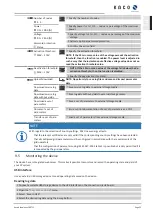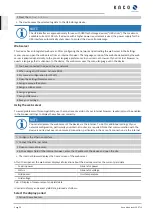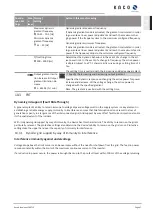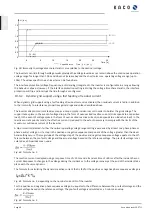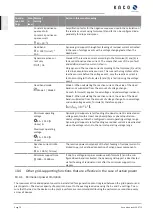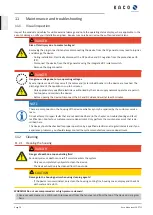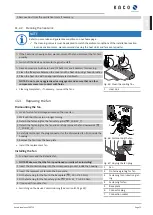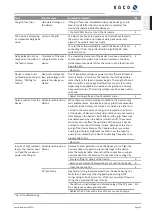
Country-
spec. Set-
tings
Men
u
level
Display/
Setting
Action in this menu/meaning
Settling time
100 – 1200000 [ms]
Determines the dynamic behaviour in the event of a change in the act-
ive power set value. With a voltage change, the active power is changed
according to a PT-1 characteristic curve with a settling time of 5 Tau.
Note: The settling time is overlaid with the increasing and decreasing
gradient.
Number of nodes
Power
0,0 – 100,0 [% P
ref
]
Voltage
80 – 125 [% U
nom
]
Up to five nodes for voltage [V] and power [% Pref] are configurable.
The power value of the first and last value pair is also used as the max-
imum or minimum active power value that is valid across the limits of
the characteristic curve.
4
1
2
3
4
Active curve
1 - 5
F
Select active curve.
NOTE: Up to 5 characteristic curves can be configured independently
and one of them can be activated for regulation each time.
10.2.3
P(f)
Adjusting the active power P(f) in the event of overfrequency
Feed-in inverters must assist with frequency stability in the grid. If the grid frequency leaves the normal tolerance range
(e.g. ±200 mHz), then the grid will be in a critical state. In the event of overfrequency, there is a generation surplus, in the
event of underfrequency, there is a generation deficit.
PV systems must adapt their feed-in power relative to the frequency deviation. In the event of overfrequency, the power
adjustment is determined by a maximum feed-in limit. The actual power of the inverter may vary freely below this limit
due to a possible fluctuation in the available power or the target value, but at no time increases above the absolute
power limit.
Fig. 53:
Equation 1
Fig. 54:
Equation 2
Equation 1 [See figure 53] [
Page 64] defines the maximum limit with ΔP relevant to 2 [See figure 54] [
Page 64], P
M
the current power at the time of activation and P
ref
the reference power. In the case of PV inverters from KACO, P
ref
is
defined as P
M
, the current power at the time of activation. f is the current frequency and f
1
is the specified activation
threshold.
Fig. 55:
Equation 3
Fig. 56:
Equation 4
The frequency f remains above the activation threshold
f
1
during an overfrequency incident. Consequently, the expres-
sion (
f
1
–
f
) is negative and ΔP corresponds to a reduction in the feed-in power.
Kaco blueplanet 29.0TL3
Page 64
EN




